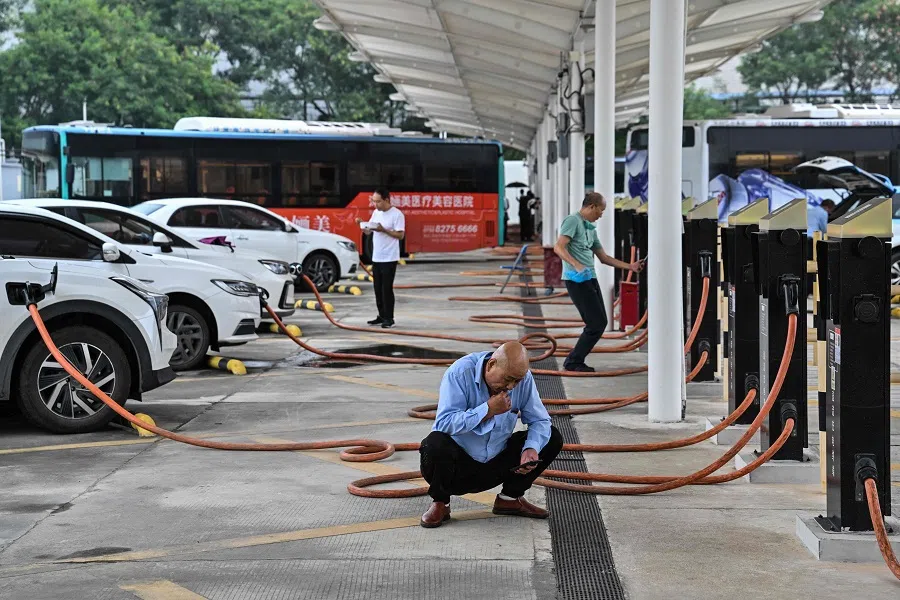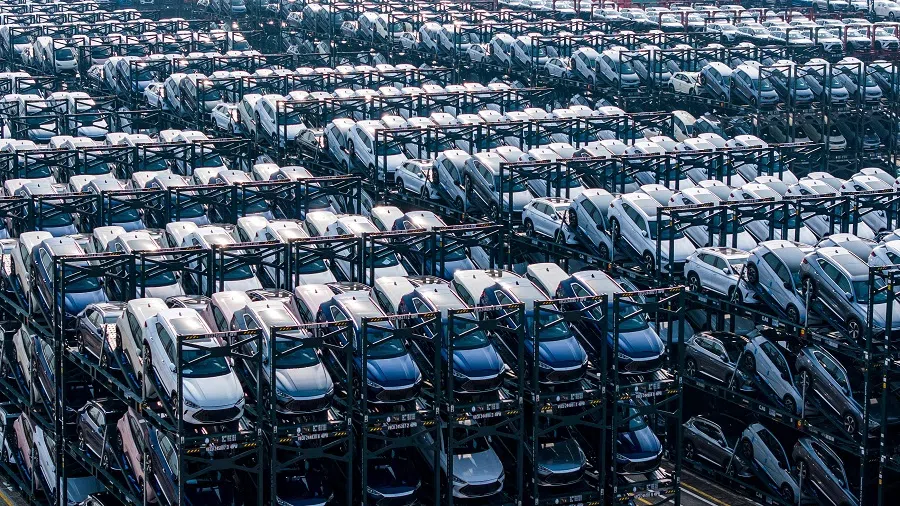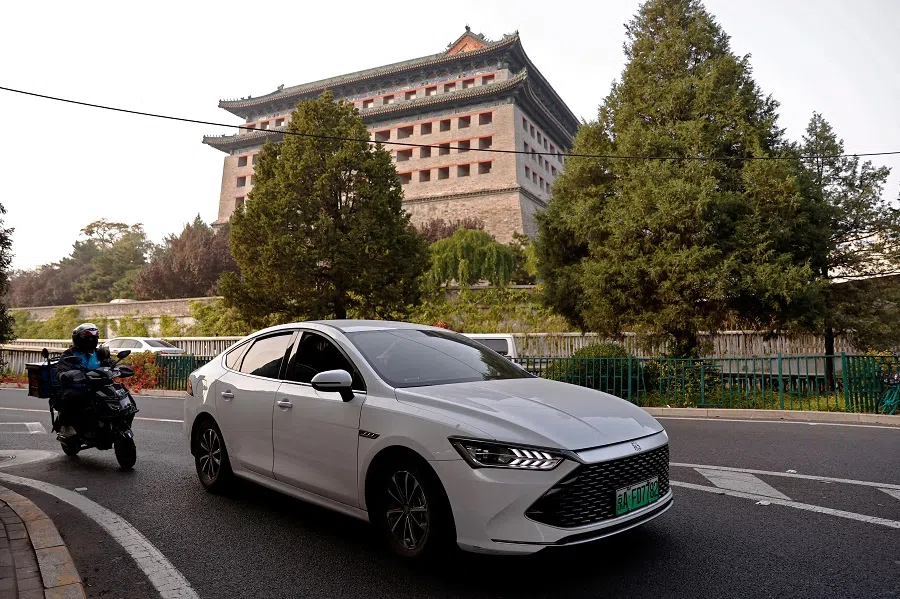More Chinese EV brands to falter as market realigns
China's electric vehicle (EV) market has seen a slew of bad news this year, with issues coming from car owners and manufacturers. While the sector is going through a necessary rite of passage for emerging industries, this is also a crucial test of whether the EV industry can uplift itself and adapt with the changing times. Lianhe Zaobao correspondent Chen Jing tells us more.

While many industries are rejoicing at the news of China's record upsurge in travellers during the Lunar New Year holiday this year, it is the contrary for the new energy vehicles (NEVs) sector.
Just as China's Spring Festival holiday was about to end, news of NEV owners abandoning their cars in Hainan made the list of top searches on Weibo. Based on media reports, return ferry tickets, especially those for NEVs, were hard to come by due to a significant surge in tourists to Hainan. Ferry service tickets for NEVs departing the island from mid-February through 2 March have reportedly been sold out. Car owners who were unable to buy a ticket could only leave their vehicles on the island and arrange for trailers to transport them after the holiday.
Myriad of issues for NEV owners
The difficulty in securing ferry tickets for NEVs leaving the island is mainly due to Hainan's Department of Transportation rule that the number of NEVs carried on a ship must not exceed 10% of the ship's vehicle quota, and the total number of vehicles must not exceed 18. This is because the environment of a passenger ferry could compromise the safety of electric vehicle (EV) batteries - NEVs are prone to fire in high temperatures or when they are not charged properly.
Some NEV owners lamented online that they would often have to "queue for an hour just to charge their vehicles for an hour".
Even if they do not visit Hainan, NEV owners also face difficulties when travelling long distances back to their hometowns. With self-driving road trips becoming the main mode of travel this Spring Festival holiday, congestion at highway charging stations has dramatically increased.
Some NEV owners lamented online that they would often have to "queue for an hour just to charge their vehicles for an hour". One person shared that the journey from Shenzhen to Jiangxi took just eight hours for a gasoline car but a whopping 15 hours for an EV.

At the same time, with blizzards, freezing rain and other natural disasters hitting various parts of China this year, the battery life of NEVs under low temperatures is in for a serious test.
Batteries drain faster in cold weather, and there are difficulties finding charging stations coupled with the long queues. Thus, after experiencing a road trip back to their hometowns this year, Chinese friends who originally loved EVs exclaimed that it would be better to drive gasoline vehicles for long-distance journeys.
Most NEV manufacturers still not profitable
Competition among automobile companies is also intensifying amid the public's changing sentiment towards NEVs.
Just after the Spring Festival holiday, BYD, China's largest EV manufacturer, fired the first shot in a price war: the price for its newly launched model is starting at less than 80,000 RMB (US$11,121), the lowest in the industry for similar models. Several other auto manufacturers followed suit, collectively announcing steep price cuts for their models.
The day BYD announced its price cut, Cui Dongshu, secretary-general of the China Passenger Car Association, predicted on his social media account that this will be a critical year for NEV enterprises to gain a foothold, and competition is bound to be fierce.
Cui believes that with the soaring penetration rate of NEVs, the market size of traditional fuel vehicles will gradually shrink, and price wars will intensify due to the mismatch between the shrinking market and the huge traditional production capacity.
Apart from one or two leading auto manufacturers that are profitable, most enterprises have yet to earn anything.

Industry practitioners had previously mentioned that most of China's NEV enterprises are still struggling to make ends meet. Apart from one or two leading auto manufacturers that are profitable, most enterprises have yet to earn anything. The Chinese government's removal of subsidies for EV purchases last year has also slowed the growth of the world's largest EV market.
Data from China's Ministry of Industry and Information Technology (MIIT) showed that sales of NEVs grew 37.9% year-on-year to 9.5 million vehicles in 2023. Although a significant increase, it was a huge drop from the 93.4% increase in 2022. Some businesses with cash-flow problems are gradually exiting the market competition.
On the first working day after the Lunar New Year, it was revealed that luxury EV manufacturer HiPhi will halt production for six months. Even though an insider source denied the claim, HiPhi held a meeting to inform its employees that it would be unable to pay their January salaries on time and advised them to "seek their own way out", highlighting the dire straits the company was in.
Internal and external challenges
With domestic competition heating up, Chinese car manufacturers have also met with more obstacles in their attempt to expand overseas. Besides the European Union's anti-subsidy probe last year into Chinese EVs, there were news reports this month claiming that the US Biden administration could employ methods other than tariffs to restrict the import of China's smart vehicles and relevant components.
... the industry is marred by disorderly competition and the haphazard launching of new projects, among other issues. - Xin Guobin, Vice-Minister, Ministry of Industry and Information Technology
Xin Guobin, a vice-minister at MIIT, stated bluntly in January that most of China's NEV companies, especially those that are focused on domestic sales, have yet to achieve profitability. Furthermore, the industry is marred by disorderly competition and the haphazard launching of new projects, among other issues. China's car manufacturers also face weak demand domestically, while externally, some countries and regions are misusing trade relief measures and protectionist practices.
Just as He Xiaopeng, CEO of Guangzhou Xiaopeng Automotive Technology, stated in an internal memo issued on the first day of the new year, "This year marks the beginning of a fierce competition for Chinese EV that may end in a 'bloodbath', and some would be eliminated from the competition."

Pressure from both inside and outside of China will intensify in the upcoming year, which will exacerbate the rivalry in the market and cause more brands to fail as the market realigns.
Internally, EV manufacturers not only have to stay afloat amid a price war with other companies, but the competition with fuel vehicles is also intensifying. Whether they can further tap into the increasingly saturated domestic market and compete for more potential customers will depend on how they manage costs while improving battery life and safety.
Externally, Chinese brands not only face high tariffs but also increasing export restrictions. The challenge of maintaining the cost advantage while navigating these obstacles, and offering customised solutions to regional customers, will increase the need for R&D, production and marketing capabilities.
This Spring Festival filled with bad news marks a watershed in the transition and consolidation of China's EVs after the initial phase of rapid development. This is a necessary rite of passage for emerging industries, and is also a crucial test of whether an industry can uplift itself and adapt to the changing times.
For China's NEVs, this perhaps is not the best year - but it is undoubtedly a year of discarding the old and breaking new grounds. Only companies that take the challenge by the horns can achieve a breakthrough and come out on top.
This article was first published in Lianhe Zaobao as "新能源车过"春劫"".

![[Big read] Paying for pleasure: Chinese women indulge in handsome male hosts](https://cassette.sphdigital.com.sg/image/thinkchina/c2cf352c4d2ed7e9531e3525a2bd965a52dc4e85ccc026bc16515baab02389ab)


![[Big read] How UOB’s Wee Ee Cheong masters the long game](https://cassette.sphdigital.com.sg/image/thinkchina/1da0b19a41e4358790304b9f3e83f9596de84096a490ca05b36f58134ae9e8f1)
